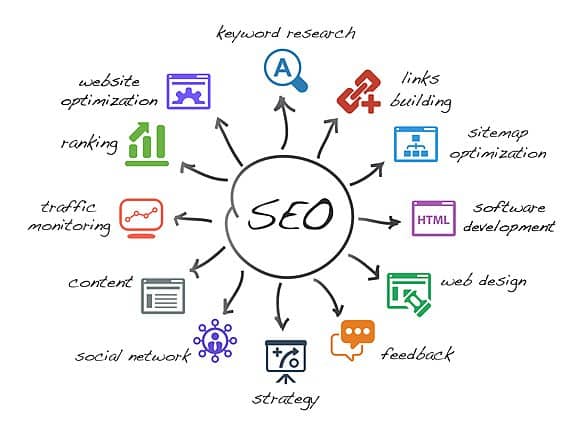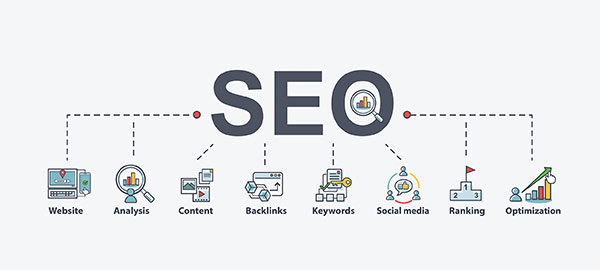Table of Contents

Introduction
In today’s digital world, SEO Optimization having a strong online presence is crucial for businesses and individuals alike. Search engines such as Google, Bing, and Yahoo drive a large amount of traffic to websites, making it important to optimize your site for search engines to reach a wider audience and achieve higher search engine rankings. In this comprehensive guide, we’ll explore the key aspects of SEO optimization and how you can improve your website’s visibility in search engine results pages.
What is SEO Optimization?

SEO, or search engine optimization, refers to the process of improving a website’s ranking in search engine results pages (SERPs). This is achieved by optimizing various elements of the site, such as the content, structure, and coding, to make it more appealing to search engines and improve its relevance for specific keywords.
Why is SEO Optimization Important?
SEO optimization is important for several reasons, including:
- Increased online visibility: By optimizing your site for search engines, you can reach a wider audience and attract more potential customers to your site.
- Improved website ranking: Higher search engine rankings can lead to improved website traffic, which can lead to more sales, conversions, and overall success.
- Better user experience: Optimizing your site for search engines can also improve the user experience by making it easier to navigate and find relevant information.
- Increased credibility: A high ranking in search engine results can improve the credibility of your site and increase the trust of your potential customers.
Step 1: Research Keywords The first step to optimizing your site for search engines is to research keywords related to your business or content. Use tools such as Google Keyword Planner to identify relevant keywords and choose those with a high search volume and low competition.
Step 2: Create High-Quality Content Creating high-quality, original content that targets your chosen keywords is crucial for SEO optimization. Your content should provide value to your audience and be optimized for both search engines and users. Here are some tips for creating SEO-friendly content:
- Target specific keywords: Incorporate your chosen keywords into your content and make sure they’re used in a natural and relevant way.
- Use header tags: Use header tags (H1, H2, etc.) to structure your content and make it easier to read.
- Optimize images: Optimize your images by using descriptive file names and alt tags, which can improve your site’s visibility in search engine results.
Step 3: Improve Site Structure The structure of your site is important for both search engines and users. Your site should have a clear and organized structure, with a clear hierarchy of pages and a logical navigation system. Here are some tips for improving your site structure:
- Use a clear and descriptive URL structure: Make sure your URLs are clear and descriptive, and use keywords if possible.
- Create a sitemap: A sitemap is a file that lists all the pages on your site and helps search engines index your content.
- Use a robots.txt file: A robots.txt file tells search engines which pages on your site to crawl and which pages to ignore.
Step 4: Optimize On-Page Elements On-page optimization refers to optimizing the content and structure of individual pages on your site. This includes optimizing page titles, meta descriptions, header tags, and images to improve their relevance and visibility in search engine results. Here are some tips for optimizing on-page elements:
- Write descriptive page titles: Your page titles should be clear and descriptive, and should include your chosen keywords if possible.
Key Elements of SEO Optimization
There are several key elements to consider when optimizing your site for search engines, including:
- Content: Content is the most important aspect of SEO optimization. It should be original, relevant, and informative, and should target specific keywords related to your business or content.
- Keywords: Keywords play a crucial role in SEO optimization. You should choose relevant keywords and incorporate them into your content, page titles, and meta descriptions to improve your site’s relevance for those keywords.
- Site structure: The structure of your site is important for search engines and users alike. Your site should have a clear and organized structure, with a clear hierarchy of pages and a logical navigation system.
- On-page optimization: On-page optimization refers to optimizing the content and structure of individual pages on your site. This includes optimizing page titles, meta descriptions, header tags, and images to improve their relevance and visibility in search engine results.
- Technical optimization: Technical optimization involves optimizing the underlying code and technical elements of your site, such as the URL structure, sitemap, and robots.txt file.
- Link building: Link building refers to acquiring links from other websites to your site. These links can help to improve your site’s credibility and visibility in search engine results.
Features
SEO Optimization: Best Features to Improve Your Website’s Search Engine Rankings
Search Engine Optimization (SEO) is a critical aspect of website development and management. With the right SEO optimization techniques, you can improve your website’s search engine rankings and reach a wider audience. In this article, we’ll look at some of the best features for optimizing your website for search engines and how you can use them to boost your website’s visibility.
- Keyword Research
Keyword research is the foundation of effective SEO optimization. By researching the keywords and phrases that are most relevant to your website, you can identify the terms that your target audience is searching for and optimize your website accordingly. There are many keyword research tools available, both free and paid, that can help you find the best keywords for your website.
- On-page Optimization
On-page optimization is the process of optimizing individual web pages to rank higher in search engines. This includes optimizing the title tag, meta description, and header tags, as well as incorporating keywords into the content and adding internal links. On-page optimization is important for both users and search engines, as it helps to improve the user experience and provide clear and concise information to search engines about what your website is about.
- Content Creation
Content creation is an important part of SEO optimization, as it helps to provide value to your visitors and improve your website’s relevance in search engines. When creating content, it’s important to focus on quality over quantity, and to include keywords and phrases that are relevant to your target audience. You should also aim to create unique and informative content that provides value to your visitors.
- Link Building
Link building is the process of acquiring links from other websites to your own. These links act as “votes of confidence” for your website and can help to improve your search engine rankings. There are many different link building strategies, including guest blogging, broken link building, and link outreach. It’s important to focus on quality over quantity when building links, and to only acquire links from reputable and high-quality websites.
- Site Architecture
Site architecture is the structure of your website and how it’s organized. A well-organized site architecture can help search engines crawl your website more efficiently and effectively, which can help to improve your website’s search engine rankings. When organizing your site, it’s important to create a clear and logical structure, with a hierarchical organization of your pages and posts.
- Technical Optimization
Technical optimization refers to the technical aspects of your website that can impact your search engine rankings. This includes optimizing your website’s load time, ensuring that your website is mobile-friendly, and ensuring that your website is secure. Technical optimization is important for both users and search engines, as it helps to improve the user experience and provide a better understanding of your website to search engines.
- Local Search Optimization
Local search optimization is the process of optimizing your website for local search queries. This includes optimizing your Google My Business listing, creating local citations, and incorporating local keywords into your content. Local search optimization is important for businesses with physical locations, as it helps to improve visibility for local search queries and reach a wider audience.
- Social Media Integration
Social media integration is an important part of SEO optimization, as it can help to improve the visibility and reach of your website. By integrating your website with social media platforms, you can increase the visibility of your website and reach a wider audience. This can include adding social sharing buttons to your website, creating social media accounts, and regularly sharing your content on social media platforms.
Techniques

SEO Optimization Techniques: Boost Your Website’s Search Engine Rankings
Search Engine Optimization (SEO) is the process of optimizing your website to rank higher in search engine results pages (SERPs) and reach a wider audience. With effective SEO techniques, you can improve your website’s visibility, attract more traffic, and increase your chances of success online. In this article, we’ll look at some of the best SEO optimization techniques for boosting your website’s search engine rankings.
- Keyword Research
Keyword research is the foundation of effective SEO optimization. By researching the keywords and phrases that are most relevant to your website, you can identify the terms that your target audience is searching for and optimize your website accordingly. There are many keyword research tools available, both free and paid, that can help you find the best keywords for your website.
- On-page Optimization
On-page optimization is the process of optimizing individual web pages to rank higher in search engines. This includes optimizing the title tag, meta description, and header tags, as well as incorporating keywords into the content and adding internal links. On-page optimization is important for both users and search engines, as it helps to improve the user experience and provide clear and concise information to search engines about what your website is about.
- Content Creation
Content creation is an important part of SEO optimization, as it helps to provide value to your visitors and improve your website’s relevance in search engines. When creating content, it’s important to focus on quality over quantity, and to include keywords and phrases that are relevant to your target audience. You should also aim to create unique and informative content that provides value to your visitors.
- Link Building
Link building is the process of acquiring links from other websites to your own. These links act as “votes of confidence” for your website and can help to improve your search engine rankings. There are many different link building strategies, including guest blogging, broken link building, and link outreach. It’s important to focus on quality over quantity when building links, and to only acquire links from reputable and high-quality websites.
- Site Architecture
Site architecture is the structure of your website and how it’s organized. A well-organized site architecture can help search engines crawl your website more efficiently and effectively, which can help to improve your website’s search engine rankings. When organizing your site, it’s important to create a clear and logical structure, with a hierarchical organization of your pages and posts.
- Technical Optimization
Technical optimization refers to the technical aspects of your website that can impact your search engine rankings. This includes optimizing your website’s load time, ensuring that your website is mobile-friendly, and ensuring that your website is secure. Technical optimization is important for both users and search engines, as it helps to improve the user experience and provide a better understanding of your website to search engines.
- Local Search Optimization
Local search optimization is the process of optimizing your website for local search queries. This includes optimizing your Google My Business listing, creating local citations, and incorporating local keywords into your content. Local search optimization is important for businesses with physical locations, as it helps to improve visibility for local search queries and reach a wider audience.
- Social Media Integration
Social media integration is an important part of SEO optimization, as it can help to improve the visibility and reach of your website. By integrating your website with social media platforms, you can increase the visibility of your website and reach a wider audience. This can include adding social sharing buttons to your website, creating social media accounts, and regularly sharing your content on social media platforms.
Conclusion
Search Engine Optimization (SEO) is a critical component of online marketing, as it helps to improve the visibility of your website and reach a wider audience. With effective SEO optimization techniques, you can boost your website’s search engine rankings, attract more traffic, and increase your chances of success online.
In conclusion, SEO optimization is a complex and ever-evolving field, and it requires ongoing effort and attention. However, by following best practices and implementing effective SEO techniques, you can improve your website’s search engine rankings, attract more traffic, and reach a wider audience. Whether you’re just starting out with SEO or are looking to improve your existing efforts, there’s never been a better time to focus on SEO optimization.
Remember, SEO optimization is a long-term strategy, and it takes time and effort to see results. However, by consistently implementing best practices and following the latest trends and advancements in the field, you can ensure that your website is optimized for success in the search engines.


